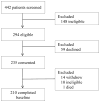Depressive symptom severity, contributing factors, and self-management among chronic dialysis patients - PubMed (original) (raw)
Observational Study
Depressive symptom severity, contributing factors, and self-management among chronic dialysis patients
Mi-Kyung Song et al. Hemodial Int. 2016 Apr.
Abstract
Despite the high prevalence of depressive symptoms in patients receiving chronic dialysis, there has been inadequate attention to patient-related barriers to management of depressive symptoms, such as factors identified by these patients as contributing to their symptoms, and how they responded to the symptoms. Participants (N = 210) in an ongoing longitudinal observational study of multidimensional quality of life in patients receiving chronic dialysis completed a battery of measures monthly for 12 months. For each patient at each measurement point, an event report was generated if he or she scored outside of the normal range on the depressive symptom scale (Center for Epidemiologic Studies Depression Scale-Short Form [CESD-SF] ≥10) or expressed suicidal ideation. Of the 210 participants, 100 (47.6%) had a CESD-SF score ≥10 at least once resulting in 290 event reports. Of these 100 participants, 15 (15%) had also reported suicidal ideation in addition to having depressive symptoms. The most frequently stated contributing factors included "managing comorbid conditions and complications" (56 event reports, 19.3%), "being on dialysis" (50, 17.2%), "family or other personal issues" (37, 12.8%), and "financial difficulties" (31, 10.7%). On 11 event reports (3.8%) participants had been unaware of their depressive symptoms. On 119 event reports (41%) participants reported that they discussed these symptoms with their dialysis care providers or primary care providers, while on 171 event reports (59%) symptoms were not discussed with their health-care providers. The prevalence of depressive symptoms is high and many patients lack knowledge about effective self-management strategies.
Keywords: Chronic dialysis; depressive symptoms.
© 2015 International Society for Hemodialysis.
Conflict of interest statement
Conflict of Interest statement:
The results presented in this paper have not been published previously in whole or part, except in abstract format. All authors have no financial conflict of interest to disclose.
Figures
Figure 1
Participants Flow
Similar articles
- Longitudinal associations of depressive symptoms and pain with quality of life in patients receiving chronic hemodialysis.
Belayev LY, Mor MK, Sevick MA, Shields AM, Rollman BL, Palevsky PM, Arnold RM, Fine MJ, Weisbord SD. Belayev LY, et al. Hemodial Int. 2015 Apr;19(2):216-24. doi: 10.1111/hdi.12247. Epub 2014 Nov 18. Hemodial Int. 2015. PMID: 25403142 Free PMC article. Clinical Trial. - Comparison of the SF-36 Five-item Mental Health Inventory and Beck Depression Inventory for the screening of depressive symptoms in chronic dialysis patients.
van den Beukel TO, Siegert CE, van Dijk S, Ter Wee PM, Dekker FW, Honig A. van den Beukel TO, et al. Nephrol Dial Transplant. 2012 Dec;27(12):4453-7. doi: 10.1093/ndt/gfs341. Epub 2012 Aug 9. Nephrol Dial Transplant. 2012. PMID: 22879393 - Symptoms of depression in kidney transplant recipients: a cross-sectional study.
Szeifert L, Molnar MZ, Ambrus C, Koczy AB, Kovacs AZ, Vamos EP, Keszei A, Mucsi I, Novak M. Szeifert L, et al. Am J Kidney Dis. 2010 Jan;55(1):132-40. doi: 10.1053/j.ajkd.2009.09.022. Epub 2009 Nov 22. Am J Kidney Dis. 2010. PMID: 19932540 - Association between depression and mortality in patients receiving long-term dialysis: a systematic review and meta-analysis.
Farrokhi F, Abedi N, Beyene J, Kurdyak P, Jassal SV. Farrokhi F, et al. Am J Kidney Dis. 2014 Apr;63(4):623-35. doi: 10.1053/j.ajkd.2013.08.024. Epub 2013 Nov 1. Am J Kidney Dis. 2014. PMID: 24183836 Review. - An interdisciplinary approach to dialysis decision-making in the CKD patient with depression.
Schell JO, Bova-Collis R, Eneanya ND. Schell JO, et al. Adv Chronic Kidney Dis. 2014 Jul;21(4):385-91. doi: 10.1053/j.ackd.2014.03.012. Adv Chronic Kidney Dis. 2014. PMID: 24969392 Review.
Cited by
- Development and Validation of a Nomogram Model for Accurately Predicting Depression in Maintenance Hemodialysis Patients: A Multicenter Cross-Sectional Study in China.
Zhou X, Zhu F. Zhou X, et al. Risk Manag Healthc Policy. 2024 Sep 3;17:2111-2123. doi: 10.2147/RMHP.S456499. eCollection 2024. Risk Manag Healthc Policy. 2024. PMID: 39246589 Free PMC article. - Constructing prediction models and analyzing factors in suicidal ideation using machine learning, focusing on the older population.
Jung HW, Jang JS. Jung HW, et al. PLoS One. 2024 Jul 22;19(7):e0305777. doi: 10.1371/journal.pone.0305777. eCollection 2024. PLoS One. 2024. PMID: 39038039 Free PMC article. - Biochemical and Sociodemographic Correlates of Major Depressive Disorder in Patients With Chronic Kidney Disease Receiving Hemodialysis.
Kumar A, Jain A, Rikhari P. Kumar A, et al. Cureus. 2023 Aug 10;15(8):e43267. doi: 10.7759/cureus.43267. eCollection 2023 Aug. Cureus. 2023. PMID: 37692732 Free PMC article. - "You need a team": perspectives on interdisciplinary symptom management using patient-reported outcome measures in hemodialysis care-a qualitative study.
Baragar B, Schick-Makaroff K, Manns B, Love S, Donald M, Santana M, Corradetti B, Finlay J, Johnson JA, Walsh M, Elliott MJ. Baragar B, et al. J Patient Rep Outcomes. 2023 Jan 20;7(1):3. doi: 10.1186/s41687-022-00538-8. J Patient Rep Outcomes. 2023. PMID: 36662325 Free PMC article. - Depression and chronic kidney disease: a cross-sectional study based at Bugando Medical Centre, Northwestern Tanzania.
Munisi H, Sylvester I, Mwakalebela I, Kanenda S, Rudovick L, Mwita M, Nyanza E. Munisi H, et al. Pan Afr Med J. 2022 Aug 22;42:297. doi: 10.11604/pamj.2022.42.297.31414. eCollection 2022. Pan Afr Med J. 2022. PMID: 36415338 Free PMC article.
References
- Farrokhi F, Abedi N, Beyene J, Kurdyak P, Jassal SV. Association Between Depression and Mortality in Patients Receiving Long-term Dialysis: A Systematic Review and Meta-analysis. Am J Kidney Dis. 2014;63:623–35. - PubMed
- van Dijk S, van den Beukel TO, Dekker FW, et al. Short-term versus long-term effects of depressive symptoms on mortality in patients on dialysis. Psychosom Med. 2012;74:854–60. - PubMed
- Neitzer A, Sun S, Doss S, Moran J, Schiller B. Beck Depression Inventory-Fast Screen (BDI-FS): an efficient tool for depression screening in patients with end-stage renal disease. Hemodial Int. 2012;16:207–13. - PubMed
Publication types
MeSH terms
LinkOut - more resources
Full Text Sources
Other Literature Sources
Medical
